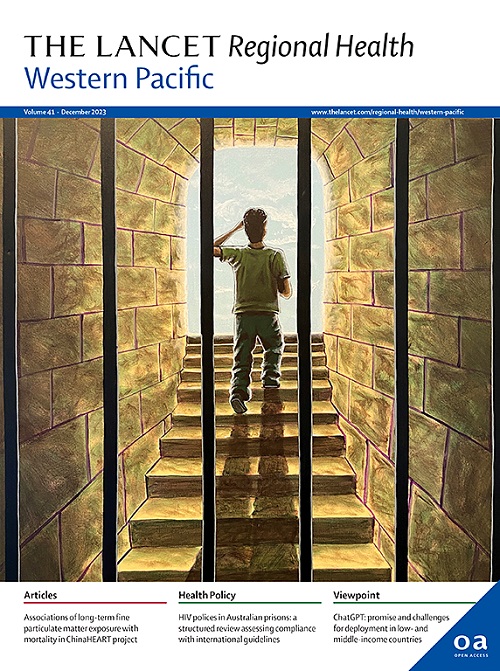Waning immunity, prevailing non-vaccine type ptxP3 and macrolide-resistant strains in the 2024 pertussis outbreak in China: a multicentre cross-sectional descriptive study
IF 8.1
1区 医学
Q1 HEALTH CARE SCIENCES & SERVICES
引用次数: 0
Abstract
Background
In the spring and summer of 2024, an unexpected large outbreak of pertussis hit China, with the annual incidence of pertussis (34.03/100,000) more than 12-fold higher than that of 2023 (2.71/100,000). We aimed to assess clinical and molecular epidemiological patterns and unravel the reasons behind the 2024 pertussis outbreak.
Methods
PCR-confirmed pertussis cases were enrolled from five sentinel hospitals in Shanghai, Anhui, Hainan, Fujian, and Inner Mongolia between 1 January and 30 September 2024. The epidemiological data of PCR-confirmed cases, as well as the clinical data and vaccination history of hospitalized cases were collected. Nasopharyngeal swab samples were collected from partial pertussis cases and their household contacts for Bordetella pertussis culture during the local peak months. Antimicrobial susceptibility testing and whole genome sequencing were performed on all 394 isolates to evaluate six antibiotic susceptibility and characterize the antigenic, virulent, and phylogenetic characteristics of the circulating isolates.
Findings
A total of 14,874 cases of pertussis were PCR-confirmed in the 5 sentinel hospitals, peaking in April to July. Infants represented 9.6% of cases and children aged 4–10 years represented 74.3% of cases in the five hospitals. Of the 7238 (48.7%) cases with vaccination data, 6563 (90.7%) were fully vaccinated. Breakthrough pertussis cases were mainly observed in fully vaccinated children since the age of 7 months. Among the 828 (5.6%) cases hospitalized for pertussis, 71.7% (594/828) cases had complications (pneumonia 69.7%, 577/828), 5.7% (47/828) were admitted to intensive care unit and 0.24% (2/828) cases died. Sixty-four per cent (403/630) of families had both the patient and at least one family member PCR-positive for B. pertussis. In total, 394 B. pertussis isolates were recovered from the 1921 nasopharyngeal swab samples. Ninety-nine point seven per cent (393/394) of isolates displayed high-level resistance to azithromycin (MIC range, 16–256 μg/ml), and 48.0% (189/394) isolates were susceptible to trimethoprim-sulfamethoxazole (MIC range, <0.008/0.152–0.5/9.5 μg/ml). All the isolates were susceptible to levofloxacin, doxycycline, ceftazidime, and cefoperazone/sulbactam. All the isolates were assigned to ST-2 and 99.5% (392/394) belonged to the MT28-Shanghai clone by SNP-based analysis, carrying ptxP3 AgST4, 23S rRNA-13 (with erythromycin resistance), and prn150. 23.4% (92/394) of isolates were predicted to be PRN-deficient.
Interpretation
The waning vaccine-derived protection and the prevailing macrolide-resistant MT28 clone harboring non-vaccine type ptxP3 are responsible for the 2024 large outbreak of pertussis in China. Our findings highlight the urgent need for revising national pertussis vaccination strategies and traditional first-line antibiotic therapy. Booster vaccination for children aged 4–6 years is urgent to control the pertussis outbreak.
Funding
This work is supported by Shanghai Municipal Sixth Round Three-Year Action Plan for Strengthening the Construction of the Public Health System (GWVI-11.1-07, GWVI-2.1.2) and National Natural Science Foundation of China (82272381).
2024年中国百日咳疫情中免疫力下降、普遍存在的非疫苗型ptxP3和大环内酯耐药菌株:一项多中心横断面描述性研究
2024年春夏,中国意外爆发百日咳大爆发,年百日咳发病率(34.03/10万)比2023年(2.71/10万)高出12倍以上。我们旨在评估临床和分子流行病学模式,并揭示2024年百日咳爆发背后的原因。方法收集2024年1月1日至9月30日在上海、安徽、海南、福建和内蒙古5个哨点医院经spcr确诊的百日咳病例。收集pcr确诊病例的流行病学资料以及住院病例的临床资料和疫苗接种史。采集部分百日咳病例及其家庭接触者的鼻咽拭子样本,在当地流行高峰期进行百日咳杆菌培养。对所有394株分离株进行了抗生素敏感性试验和全基因组测序,以评估6种抗生素的敏感性,并对循环分离株的抗原性、毒性和系统发育特征进行了表征。结果5所哨点医院pcr确诊百日咳病例14874例,高峰期在4 ~ 7月。在这五家医院中,婴儿占9.6%,4-10岁儿童占74.3%。在7238例(48.7%)有疫苗接种资料的病例中,6563例(90.7%)完全接种了疫苗。突破百日咳病例主要发生在7个月以后完全接种疫苗的儿童中。828例百日咳住院患者(5.6%)中,71.7%(594/828)出现并发症(肺炎69.7%,577/828),5.7%(47/828)住院,死亡0.24%(2/828)。64%(403/630)的家庭患者和至少一名家庭成员均为百日咳聚合酶链反应阳性。从1921份鼻咽拭子中共分离出394株百日咳杆菌。99.7%(393/394)的分离株对阿奇霉素呈高耐药(MIC范围为16 ~ 256 μg/ml), 48.0%(189/394)的分离株对甲氧苄啶-磺胺甲恶唑呈敏感(MIC范围为0.008 ~ 0.157 ~ 0.5/9.5 μg/ml)。所有菌株均对左氧氟沙星、多西环素、头孢他啶和头孢哌酮/舒巴坦敏感。所有分离株均为ST-2型,99.5%(392/394)属于MT28-Shanghai克隆,携带ptxP3 AgST4、23S rRNA-13(红霉素耐药)和prn150。23.4%(92/394)的分离株预测prn缺失。疫苗衍生保护作用的减弱和普遍存在的含非疫苗型ptxP3的大环内酯耐药MT28克隆是导致2024年中国百日咳大爆发的原因。我们的发现强调了修订国家百日咳疫苗接种策略和传统一线抗生素治疗的迫切需要。为控制百日咳爆发,迫切需要为4-6岁儿童加强接种疫苗。上海市第六轮加强公共卫生体系建设三年行动计划项目(GWVI-11.1-07, GWVI-2.1.2)和国家自然科学基金项目(82272381)资助。
本文章由计算机程序翻译,如有差异,请以英文原文为准。
求助全文
约1分钟内获得全文
求助全文
来源期刊

The Lancet Regional Health: Western Pacific
Medicine-Pediatrics, Perinatology and Child Health
CiteScore
8.80
自引率
2.80%
发文量
305
审稿时长
11 weeks
期刊介绍:
The Lancet Regional Health – Western Pacific, a gold open access journal, is an integral part of The Lancet's global initiative advocating for healthcare quality and access worldwide. It aims to advance clinical practice and health policy in the Western Pacific region, contributing to enhanced health outcomes. The journal publishes high-quality original research shedding light on clinical practice and health policy in the region. It also includes reviews, commentaries, and opinion pieces covering diverse regional health topics, such as infectious diseases, non-communicable diseases, child and adolescent health, maternal and reproductive health, aging health, mental health, the health workforce and systems, and health policy.
 求助内容:
求助内容: 应助结果提醒方式:
应助结果提醒方式:


